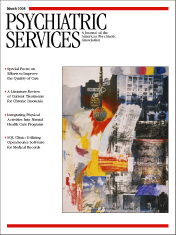Patterns and Quality of Treatment for Patients With Schizophrenia in Routine Psychiatric Practice
Abstract
OBJECTIVES: This study provided generalizable national data on the treatment of adult patients with schizophrenia in the United States and assessed conformance with the practice guideline treatment recommendations of the Schizophrenia Patient Outcomes Research Team and the American Psychiatric Association. METHODS: National data from the American Psychiatric Institute for Research and Education's 1999 Practice Research Network study of psychiatric patients and treatments were used to examine treatment patterns for 151 adult patients with schizophrenia. Analyses were performed and adjusted for the weights and sample design to generate nationally representative estimates. RESULTS: Findings indicated that patients with schizophrenia who were treated by psychiatrists had complex clinical problems and were markedly disabled. Forty-one percent of patients had a comorbid axis I disorder, and 75 percent were currently unemployed. Thirty-five percent were currently experiencing medication side effects, and 37 percent were currently experiencing problems with treatment adherence. Although most patients received guideline-consistent psychopharmacologic treatment, treatment was characterized by significant polypharmacy. Rates of conformance with the guideline recommendations were significantly lower for psychosocial recommendations than for psychopharmacologic recommendations. Although 69 percent of patients received at least some psychosocial treatment, none of the unemployed patients received vocational rehabilitation services in the past 30 days. CONCLUSIONS: These data suggest unmet need for psychosocial treatment services among individuals with schizophrenia. These findings raise questions about whether currently available antipsychotic medications are being used optimally or whether they offer limited effectiveness for patients with complex clinical problems who are treated in routine psychiatric practice.



